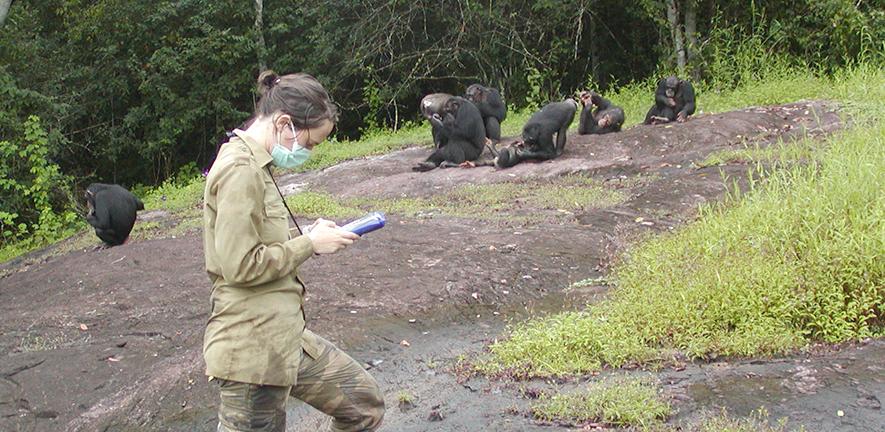
Despite significant protection efforts, global populations of monkeys and apes are declining dramatically. A new study has found that the effectiveness of protection measures is rarely evaluated, and calls for an evidence-based approach to future conservation efforts to prevent imminent extinctions.
Despite significant protection efforts, global populations of monkeys and apes are declining dramatically. A new study has found that the effectiveness of protection measures is rarely evaluated, and calls for an evidence-based approach to future conservation efforts to prevent imminent extinctions.
Our findings imply that many primate conservation activities are carried out without demonstrably knowing if they have worked or not in other similar situations. This is alarming.
Silviu Petrovan
Primates are the group of mammals that includes monkeys, apes, lemurs – and humans. There is far more research and conservation funding for non-human primates than other animal species, due largely to their charisma and their close relationship with humans. Despite this, about 60 percent of primate species are now threatened with extinction and 75 percent have declining populations.
In a study published today in the journal BioScience, a team of experts in 21 countries examined 13,000 primate studies. They found a severe lack of evidence for the effectiveness of primate conservation measures.
The team found only 80 primate studies that investigated the effectiveness of conservation measures. In addition, only 12 percent of threatened primates and 14 percent of all known primate species were covered by these intervention studies. The studies focused on large-bodied primates and Old World monkeys, particularly great apes, but left out entire families such as tarsiers and night monkeys.
Despite the taxonomic biases, the authors also found that primate studies were biased towards specific geographic regions and interventions. Fewer than half of the 162 possible primate conservation activities identified by primate experts were evaluated quantitatively.
Likewise, almost 80 percent of tested interventions were of unknown effectiveness. This was due to studies lacking quantitative data, difficulties in undertaking post-implementation monitoring of populations or individuals, or implementing several interventions at once.
“Our findings imply that many primate conservation activities are carried out without demonstrably knowing if they have worked or not in other similar situations. This is alarming, given the urgent need for effective conservation measures for these species. Primate conservationists need to showcase the most effective actions for others to learn from,” said Dr Silviu Petrovan in the University of Cambridge’s Department of Zoology, who co-led the research.
“Whether a species was threatened or not played no role for the scientists in the choice of their studied species. We therefore lack the evidence-based information necessary to effectively protect and manage many vulnerable species,” said Dr Jessica Junker at the German Centre for Integrative Biodiversity Research (iDiv) and the Max Planck Institute for Evolutionary Anthropology (MPI-EVA), who co-led the research with Dr Petrovan.
The study outlines several reasons for the lack of evidence on what works in primate conservation. These include the pattern of survival and reproduction events typical for members of this taxonomic group, also referred to as life history traits.
“Primates tend to occur at low densities, have slow life histories, and their tree-dwelling habits make them difficult to count. This requires innovative methods and intense monitoring over long periods, specific knowledge and hard-to-obtain long-term funding,” said Hjalmar Kühl at iDiv, MPI-EVA, senior author of the study.
The authors say there is another disincentive for primate researchers to conduct evaluations of their primate conservation work: publishing can be extremely time and resource intensive, and difficult to achieve in high impact science journals, especially when the results show that a conservation measure was not effective.
They propose several measures to improve the evidence-base for primate conservation. These include: raising resources for intervention-effectiveness testing and publication, developing guidelines for primate conservation activities, shifting the research focus to threatened species and understudied regions, and seeking long-term collaborations with stakeholders.
The study was led by researchers from the German Centre for Integrative Biodiversity Research (iDiv), the Max Planck Institute for Evolutionary Anthropology (MPI-EVA) and the University of Cambridge.
Adapted from a press release by the German Centre for Integrative Biodiversity Research (iDiv).
Reference
Junker, J. & Petrovan, S. O., ‘Severe Lack of Evidence Limits Effective Conservation of the World’s Primates.’ BioScience, 2020. DOI: 10.1093/biosci/biaa082

The text in this work is licensed under a Creative Commons Attribution 4.0 International License. Images, including our videos, are Copyright ©University of Cambridge and licensors/contributors as identified. All rights reserved. We make our image and video content available in a number of ways – as here, on our main website under its Terms and conditions, and on a range of channels including social media that permit your use and sharing of our content under their respective Terms.




